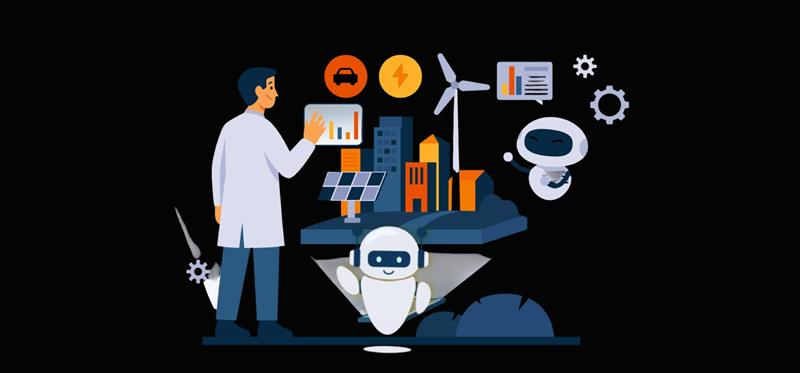Optimizing Resource Management with RPA and AI in Energy Automation
Resource efficiency is becoming a defining factor in the competitiveness of modern energy providers. Whether dealing with power generation, distribution, or consumption, decision-makers are now seeking solutions that streamline operations and minimize waste. Technologies like Artificial Intelligence and RPA in energy sector are proving to be indispensable allies in making this happen.
What Challenges Does the Energy Sector Face in Resource Management?
Energy companies today navigate a wide spectrum of challenges such as:
Complexity Across the Value Chain
The energy lifecycle, from production to distribution, involves multiple checkpoints where inefficiencies or delays can escalate operational costs and interrupt supply. Managing these interconnected systems manually often leads to slow processes and resource wastage.
High Dependence on Manual Data Handling
Traditional energy workflows still rely heavily on human intervention for tasks like meter reading validation, compliance documentation, and outage management. This not only introduces the risk of human error but also consumes valuable time that could be spent on strategy or innovation.
Demand Volatility and Grid Load Fluctuations
Seasonal consumption patterns, unpredictable weather conditions, and changing industrial demands make it difficult for energy companies to plan and distribute resources efficiently without real-time insight and automation.
How Does RPA Support Resource Optimization in the Energy Industry?
RPA offers task automation that improves accuracy, saves time, and frees human teams for strategic work. Here’s how RPA in energy sector workflows empowers companies:
Key Applications of RPA in Energy
| Use Case | Function | Benefits |
| Metering & Billing | Automated extraction of meter readings and automated bill generation based on pre-set criteria | Enhances billing accuracy, reduces turnaround time, and minimizes human workload |
| Asset Monitoring | Triggers alerts for performance inconsistencies or upcoming maintenance needs | Helps companies avoid expensive equipment failures and extend asset life cycles |
| Compliance Reporting | Auto-populates regulatory forms with collected data and submits them on schedule | Ensures consistent adherence to compliance standards with minimal oversight |
| Vendor Management | Automates repetitive processes like invoice reconciliation, payment scheduling, and agreement renewals | Delivers better vendor relationships and efficient supply chain coordination |
| Customer Onboarding | Captures customer inputs, validates details, and activates accounts on connected systems | Speeds up customer acquisition while reducing errors and service delays |
The RPA market in the energy and utilities sector is expected to rise from nearly USD 1.5 billion in 2024 to over USD 8 billion by 2033, reflecting a steady annual growth rate of roughly 22–25%. (Verified Market Reports)
Where Does AI Step in to Enhance Energy Automation?
While RPA handles rules-based processes, AI adds intelligence for pattern recognition, optimization, and prediction.
Example AI Use Cases in Energy Automation
- Demand Forecasting: AI can analyze years of historical consumption data and evolving user patterns to predict future load requirements. This helps energy companies optimize generation and minimize wastage.
- Predictive Maintenance: By monitoring real-time data from sensors embedded in equipment, AI models can alert teams ahead of potential breakdowns, thus saving high repair costs and preventing unexpected service interruptions.
- Load Balancing for Grid Stability: AI can dynamically distribute power across multiple sources, like renewable energy plants and traditional grids, ensuring a consistent supply even during spikes in demand.
- Smart Grid Analytics: AI decodes complex user behavior and consumption trends, enabling providers to make informed decisions on pricing models, service plans, and supply routes.
- Renewable Energy Integration: AI algorithms can map weather forecasts and power outputs from solar or wind farms to schedule their contribution efficiently into the grid, reducing dependency on fossil fuels.

How Do RPA and AI Work Together in Energy Management?
The synergy between RPA and AI allows companies to unlock advanced capabilities. RPA efficiently executes high-volume repetitive tasks, such as transferring data between systems, applying rule-based decisions, and generating reports, laying the groundwork for operational efficiency. Whereas AI augments this efficiency by analyzing both real-time and historical data, recognizing patterns and anomalies that can inform smarter decisions and long-term improvements.
By 2026, 30% of enterprises will automate over 50% of their network activities (Gartner).
What Are the Business Benefits of AI and RPA in the Energy Sector?
- Agile Decision-Making Across Operations: With AI predictions and real-time RPA execution, energy businesses can respond proactively, not reactively.
- Steady Cost Reductions: By drastically reducing manual labor costs and minimizing asset downtime, automated systems bring long-term financial efficiency.
- Improved User and Vendor Relationships: Faster service, accurate billing, and timely communication enhance trust with both customers and third-party partners.
- Aligned Sustainability Strategies: Data-driven insights ensure that resource planning and usage align with eco-conscious business goals.
- Operational Clarity and Transparency: Employees and managers get centralized dashboards and automated logs that reveal the full picture of system performance.
Conclusion
Energy companies are no longer debating whether automation is necessary; they are exploring how to integrate RPA and AI seamlessly into resource management. The combination of predictive intelligence and task automation unlocks a new level of efficiency and reliability, paving the way for a smarter, sustainable energy future.
FAQs
What roles can RPA play in energy billing?
RPA can automate every phase of the billing lifecycle, from capturing readings to generating invoices and adjusting billing cycles, resulting in faster, more accurate billing with reduced manual work.
How is AI helpful for renewable energy providers?
AI simplifies the unpredictability of solar and wind power by analyzing climate data and forecasting production potential, helping providers avoid overproduction or shortages.
Can small energy companies benefit from RPA?
Yes, even small-scale providers can see major gains by automating repetitive tasks such as report generation, billing, customer support, and compliance, freeing up resources for innovation.
Do RPA and AI replace human jobs in the energy industry?
Instead of replacing jobs, these technologies shift repetitive work away from people, enabling teams to focus on high-value tasks like strategy, engineering improvements, and customer engagement.
What’s the first step in adopting RPA for energy operations?
Start with a thorough audit of your existing processes to pinpoint repetitive, rules-based tasks. Then, develop a phased implementation roadmap with clear objectives and success metrics.

 contact
contact

 By
By 


